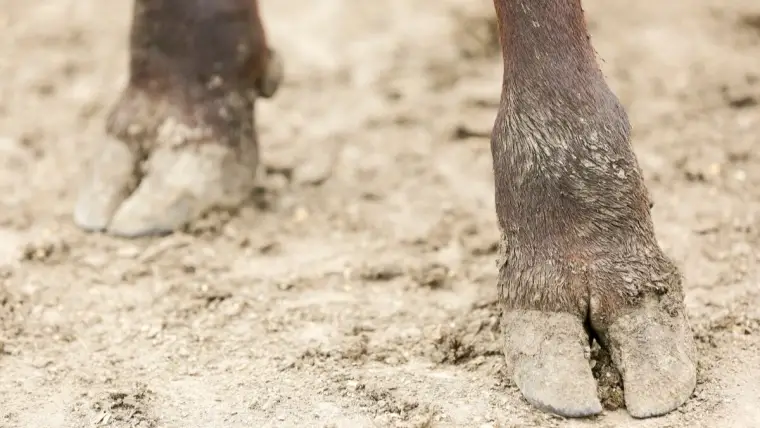
Hoof rot in goats is a common yet debilitating condition that affects the overall health and well-being of your beloved livestock. It is primarily caused by bacteria thriving in moist and damp conditions, leading to severe damage to the hoof wall if left untreated.
In this blog post, we will explore the causes, symptoms, treatment options, and preventative measures for hoof rot in goats to ensure you can maintain optimal hoof health for your goats.
Table of contents
Goat Hoof Rot Key Takeaways
- Hoof rot in goats is a common and debilitating condition caused by two bacteria that thrive in wet and damp environments – Fusobacterium necrophorum and Dichelobacter nodosus.
- Proper hoof care, regular inspections, maintaining clean living spaces, providing foot baths with zinc sulfate or copper sulfate solution, herbal remedies like lavender or cinnamon essential oil used topically can help prevent and treat hoof rot in goats.
- Untreated foot rot can lead to decreased milk and meat production, delayed conception rates, increased veterinary costs, and is the costliest disease in the sheep and goat industry. Therefore prevention via good animal husbandry practices (such as regular inspections and quarantining new animals) contributes positively to overall animal welfare leading to increased economic returns for farm owners.
- Early detection followed by prompt action leads to better recovery results while saving time and resources spent on long-term medical management plans!
Understanding Hoof Rot In Goats
Hoof rot in goats is caused by two bacteria, Fusobacterium necrophorum and Dichelobacter nodosus, which thrive in wet and damp environments between the toes.
Hoof rot in goats is contagious, therefore it requires excellent animal husbandry practices to contain it. It is important in particular to isolate sick goats, quarantine new goats, and thoroughly inspect all the hooves of all goats on regular basis. Begin treatment at the first signs of inflammation.

Causes Of Goat Hoof Rot
Goat Hoof rot is a painful and debilitating condition caused by the interaction of two bacteria – Fusobacterium necrophorum and Dichelobacter nodosus. It starts out as foot scald or interdigital dermatitis, but if left untreated can progress to necrotic virulent hoof rot in goats (also called footrot in goats).
For example, Southeast farms like those in North Carolina often experience higher cases of hoof rot due to their climate conditions. Goats with contaminated soil in their living areas are at an increased risk for developing hoof rot because these bacteria can easily penetrate the soft tissue between the toes (interdigital space) causing inflammation and infection.
One key factor that enables this detrimental process is the presence of pre-existing skin damage which could be from rough terrain or sharp objects on the ground.
Symptoms And Diagnosis of Hoof Rot in Goats
One of the first indicators that a goat may be suffering from hoof rot is limping or reluctance to bear weight on the affected foot. This lameness is due to the inflammation and discomfort caused by bacteria, such as Fusobacterium necrophorum and Dichelobacter nodosus, which invade the interdigital space between a goat’s toes.
If left untreated, the disease can progress, destroying the hoof tissue, and then exposing and killing the soft flesh underneath.
To diagnose goat hoof rot accurately, visually examine your goat’s hooves for abnormalities such as swelling or redness in the interdigital area, separation of hoof tissue layers or spread of infection into deeper structures within the foot.
A foul odor emanating from your goat’s feet could also signify an ongoing infection or necrosis. For an accurate diagnosis and appropriate treatment plan tailored specifically for your herd needs, it is crucial to consult with a veterinary professional or County Extension agent well-versed in sheep and goat industry challenges like these.
Treating Hoof Rot In Goats
To effectively treat hoof rot in goats, it’s important to understand conventional treatments like foot baths with copper sulfate and long-acting antibiotics, as well as alternative options such as essential oil soaks.
Conventional Treatments
Goat owners can effectively treat hoof rot in their animals through various conventional methods, including:
- Trimming the excess hoof: Use sharp hoof trimmers to carefully remove any overgrown or damaged parts of the hoof that may be contributing to hoof rot.
- Cleaning the infected tissue: Utilize a damp rag or soft-bristled brush to gently clear away debris and dirt from the affected area prior to treatment.
- Applying Hoof n’ Heel: This is a widely used treatment for thrush in goats, which can also be effective for treating hoof rot when applied generously over the infected foot after cleaning.
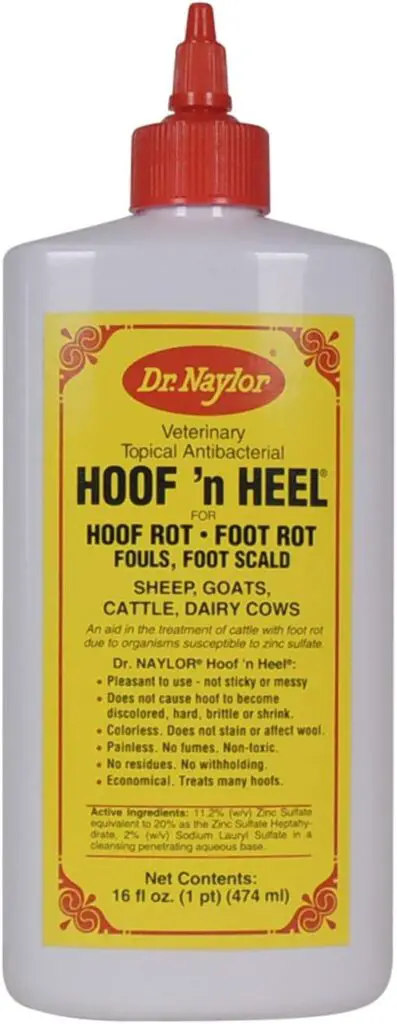
- Administering antibiotics: In severe cases, veterinarians may prescribe antibiotics such as penicillin or oxytetracycline to manage the bacterial infection causing hoof rot.
- Soaking feet in a diluted bath of zinc sulfate or copper sulfate solution: A foot bath of containing zinc sulfate or copper sulfate can help eliminate bacteria present on the goat’s hooves and provide relief during the healing process. Zinc is preferred as Copper is more toxic to goats, and can stain their coat. Use the baths carefully and follow the directions.
- Veterinary consultation: It’s essential to consult with a veterinarian if your goat is experiencing severe lameness, persistent pain, or shows no signs of improvement despite treatment efforts.
By following these conventional treatments and closely monitoring their goats’ recovery, owners can help ensure their animals return to optimal health and prevent future instances of hoof rot.
Herbal And Essential Oil Treatments
In addition to conventional treatments, there are a few herbal and essential oil remedies that may help in treating hoof rot in goats. Here are some options to consider:
- Lavender essential oil: With its antibacterial and antifungal properties, lavender essential oil may be effective in combating the bacteria responsible for causing hoof rot.
- Oil of garlic: Another option with antibacterial properties is garlic oil, which can be applied topically to the affected area.
- Tea tree oil: Known for its antiseptic properties, tea tree oil can be added to a foot soak solution or applied topically to help fight infection.
- Cinnamon oil: Cinnamon essential oil has antifungal and antimicrobial activity and can be used as an alternative treatment for foot rot in goats.
- Clove oil: This essential oil has antimicrobial activity and can be used in combination with other oils as a topical application to help reduce inflammation and promote healing.
- Peppermint oil: Peppermint essential oil has been found to have both antibacterial and antifungal properties and therefore may aid in treating goat hoof issues like foot rot.
It’s important to remember that while herbal remedies may provide some relief, it’s still essential to consult a veterinarian before attempting any new treatments. Additionally, traditional methods like proper hoof care, regular inspections, and maintaining a clean environment should always remain a priority.
Preventing Hoof Rot In Goats
To prevent hoof rot in goats, proper hoof care and maintenance are essential.
Proper Hoof Care And Maintenance
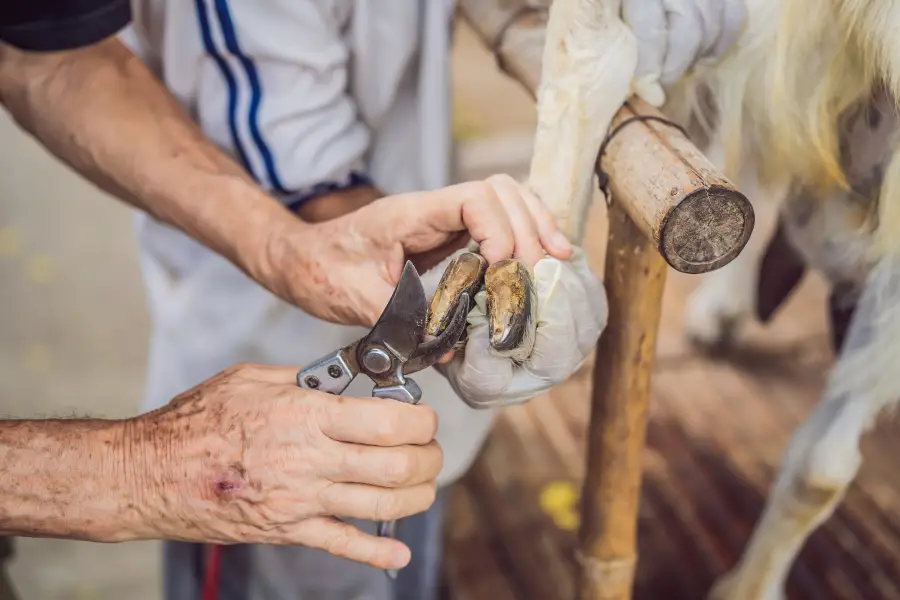
Proper hoof care and maintenance is essential to prevent hoof rot in goats. Here are some tips:
- Regular trimming: Trim your goat’s hooves every 4-6 weeks, or as needed. Overgrown hooves can lead to stress on the feet and increase the risk of infection.
- Use proper tools: Invest in a good pair of hoof trimmers and a hoof pick. This will help you work efficiently, safely, and effectively.
- Clean hooves regularly: Check your goats’ hooves daily for signs of debris, dirt buildup or moisture accumulation. Clean their hooves with a damp cloth or brush, especially after they have been outside.
- Keep goats dry: Keep goats in a dry and clean environment to minimize exposure to infectious agents. Moisture and humidity provide an ideal environment for microorganisms that cause hoof rot.
- Provide access to a dry pasture: If you don’t have access to a barn, ensure that your pasture is well-drained and not muddy. Goats should be kept away from wet areas during rainy season.
- Foot baths: Provide foot baths with a zinc sulfate or copper sulfate solution (4-10%% concentration) once a week. This will help kill bacteria that may cause hoof issues like rot or scalds.
By following these simple steps, you can reduce the risk of hoof rot in your goats and keep them healthy overall. Don’t forget to seek veterinary assistance if necessary, especially if symptoms persist even after treatment.
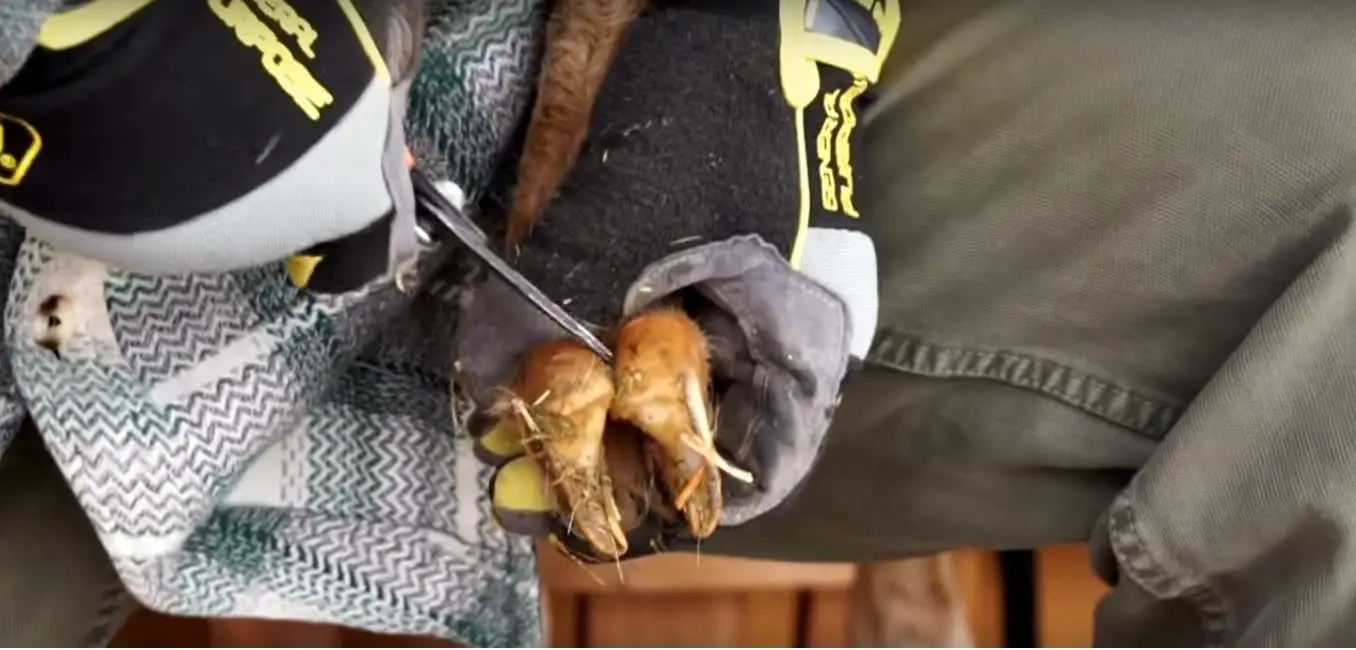
Regular Hoof Inspections
Regular hoof inspections are crucial in preventing and catching early signs of hoof rot in goats. By regularly examining your goat’s feet, you can detect issues such as swelling, redness, or foul odor that may indicate an infection.
Early detection allows for more effective treatment and can prevent the spread of infection to other animals in your herd.
During an inspection, it is important to examine the area between the toes thoroughly as this is where bacteria thrive in moist conditions. Trimming excess hoof growth can also help reduce the risk of infection by providing a cleaner environment for your goat’s feet.
Additionally, keeping a record of your inspections and any issues detected can help identify trends or patterns over time and aid in developing preventative measures specific to your herd’s needs.
Environmental Management
Keeping a clean and dry environment is crucial in preventing hoof rot in goats. Goats thrive in a dry and well-ventilated area, so it’s important to provide them with access to a barn or shelter during wet seasons.
Muddy pastures can be breeding grounds for bacteria that cause hoof rot; thus, allow your goats access to pasture only when the ground is not too wet. Regular cleaning of bedding material also helps prevent infection.
Foot baths containing zinc or copper sulfate solution can be set up at the entrance of their housing areas as well. Remember, prevention is key to keeping your goats healthy and eliminating potential economic loss due to lameness caused by hoof rot infections.
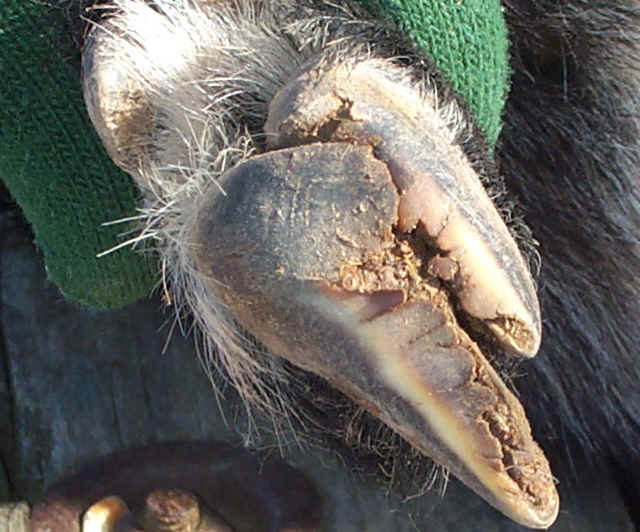
Importance Of Goat Hoof Health
Proper goat hoof health is essential for maintaining the overall health and well-being of goats, as it can impact their ability to move and graze comfortably.
Impact On Overall Health And Well-being
Hoof rot can have a significant impact on the overall health and well-being of goats. It can cause lameness, which makes it difficult for them to move around and access water and food, leading to poor growth and weight loss.
In severe cases, untreated hoof rot infections can spread throughout the entire body causing systemic illness or even death. Preventing hoof rot through proper hygiene practices such as regular foot inspections, quarantine measures for new animals entering the herd, and the use of zinc sulfate or copper sulfate footbaths help to ensure that your goats remain healthy.
Economic Implications For Goat Farmers
Maintaining good hoof health in goats is crucial for a profitable goat farm. Foot rot, if not controlled, can result in decreased milk and meat production, delayed conception rates, and increased veterinary costs.
In high rainfall areas of the USA, foot rot has been identified as the costliest disease in the sheep and goat industry.
Goat farmers who prioritize hoof care are more likely to see improved productivity from their herds since they are less likely to suffer from lameness caused by foot rot.
Additionally, preventing outbreaks means that farmers do not have to invest heavily in medication or perform costly treatments on (or cull) their animals.
To put it into perspective: producers with Dichelobacter nodosus-free flocks are able to sell replacement breeding stock at premium prices since buyers assume lower risk in purchasing animals free of this disease.
Video- Official Video from North Carolina State University Extension – Prevent Goat Hoof Rot
In this official video from NC State Extension, you will see a demonstration by Livestock Extension Agent, Lauren Langley on how to properly trim your goat’s hooves. Proper trimming of hooves is one of the key factors to prevent hoof rot in goats.
Conclusion
Hoof rot can be a serious issue in goats, causing lameness and discomfort if left untreated. Prevention is key, with proper hoof care, regular inspections, and environmental management.
If your goat develops hoof rot, it’s important to seek veterinary consultation and use appropriate treatments like foot baths or antibiotics. Remember to isolate infected goats from the rest of the herd and practice biosecurity measures to prevent the spread of disease.
FAQ’s about Goat Hoof Rot
Hoof rot is a bacterial infection that affects the hooves of goats. It occurs when dirt, manure or other debris gets trapped between the toes and causes irritation to the skin.
Signs of hoof rot include limping, swelling in the affected area, discharge from the infected hoof, and a foul smell coming from your goat’s feet. If you suspect your goat may have hoof rot, consult with an experienced veterinarian as soon as possible for proper diagnosis and treatment options.
Regular inspection and cleaning of goat hooves can help reduce the risk of developing this condition. Providing clean living conditions such as dry bedding on well-drained soil will also help prevent moisture accumulation that could contribute to bacterial growth in their hooves.
Treatments for hoof rot often begin with trimming back any overgrown or damaged tissue around the affected area before applying antiseptic solutions such as iodine or hydrogen peroxide directly onto infected areas several times daily until they heal completely. Using Zinc baths also help.
In severe cases antibiotics may be necessary under veterinary supervision but should only be employed judiciously given concerns about antibiotic resistance among livestock populations worldwide which makes it important farmers consult vets before using them on their animals unless absolutely necessary due to life-threatening circumstances where failure treat with these medicines would compromise animal welfare significantly.
Hoof scald is early stage inflammation. If left untreated, it can lead to hoof rot, which is necrotic.
Fusobacterium necrophorum and Dichelobacter nodosus are the bacteria that cause hoof rot.
Thrush is caused be yeast. If left untreated, bacteria can get into the wound which can lead to hoof rot.




